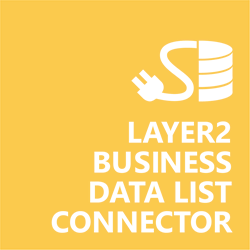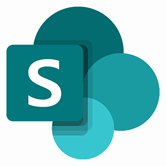Keep your Sharepoint in sync. Download and try today.
Microsoft Visual FoxPro and dBase (DBF) Data Integration with SharePoint
Microsoft Visual FoxPro and dBase(DBF) data can be integrated codeless with native SharePoint lists using the Layer2 Business Data List Connector via OLEDB. Please take a look here for more supported systems and applications. In case you are looking for Online data integration, you will find the right tool here.

Benefits of Visual FoxPro and dBase (DBF) Integration in SharePoint
- Very easy to setup in a few minutes: Create a SharePoint list, e.g. contacts, click "Connect to external data source" in the list settings, select the data provider, enter connection settings and data query as shown below.
- No changes in your FoxPro database and installation: No programming, no changes in the external data source, no additional tools. FoxPro data is presented in a native SharePoint list with all SharePoint features.
- Connected data always up-to-date: The connected FoyPro data updates automatically in background (via SharePoint Timer Job), or alternatively, on-demand (Action Menu / Ribbon Button, URL, via workflow, API).
- One-way and optional two-way connection: You can write-back the changes made in SharePoint to the FoxPro data source automatically with full CRUD (Create / Update / Delete) functionality. The SharePoint list can act as a full-featured front-end for external systems.
- Well-known BCS "external list" issues and limitations are completely solved: ALL list features are to you. Views, sorting and grouping, filters, calculated fields, search, managed metadata. Lookups, additional columns and attachments can be created as normal. All kind of lists can be used, e.g. contacts, tasks, calendar, or custom lists. You can take external data offline via Outlook.
- Workflows and notifications on external data change: List workflows and change notifications per RSS or email can be used to take business actions in SharePoint, when FoxPro data records are changed.
- Application logging, reporting, and notifications: A SharePoint list is used to store settings and log information. SharePoint item versioning and workflows can be used to manage reporting and notifications. Direct notification per email in case of errors is supported as well.
- Highest Security, best performance, easy to maintain: SharePoint Secure Store can be used to store security relevant configuration information safely in one central place. Users are working with the SharePoint lists as an external data cache with highest security and performance.
- 100+ external systems supported: Layer2 Data Providers included (e.g. for SharePoint/Office 365, Exchange, Dynamics, OData, XML/RSS, SOAP), vendor specific data providers can be used (e.g. SQL Server Oracle, mySQL etc.), 3rd party data providers also supported, e.g. for ERP/CRMs, Facebook or Twitter. See here for supported systems and applications.
Microsoft Visual FoxPro and dBase (DBF) Specific Configuration Settings
In the Layer2 Business Data List Connector the data source must be configured as follows to connect a given SharePoint list to FoxPro or dBase.

Figure 1: Sample connection configuration to connect to FoxPro or dBase via Layer2
Please note the following about settings, features and possible issues.
- Please select the generic OLEDB Data Provider (should be already installed). Please install the FoxPro dBase driver as well.
- The data source points to the directory that contains the FoxPro files (not to any specific file). Please note that often one file is not enough. FoxPro needs the database file, the datatable file and additional index files to be in the directory. You can add a password if required. Verify the connection string. In case you got "Installable ISAMs not found" please verify installation and connection string.
- The data source path can be both, local (e.g. C:\databases\mydb.dbf) or on file share (e.g. \\myShare\datatables\). In both cases please make sure that the database can be accessed from current user context. The user context is the currently logged in user or the service account (in case of scheduled background updates). In many cases a local account is used for the Windows Service with no access to file shares. You can change, if required.
- You will find more information about connection strings here.
- Enter the data query, e.g. select * from myTable. MyTable is the file name. You should remove unwanted fields later on. You can make use of all SQL queries that FoxPro OLE driver understands.
- In case of a bi-directional connection make sure that your query is updatable and you have appropiate access rights. Verify the data query and display preview data (via the actions menu) to take a look to fields and data.
- Find a unique column to use as primary key (productid in this sample).
- Bi-directional sync is generally supported.
Do you have any issues to connect? Please contact [email protected] for next steps.
Microsoft Visual FoxPro and dBase (DBF) SharePoint Connection Details
Provider:
.Net Framework Data Provider for
OleDb
Connection string sample:
Provider=VFPOLEDB.1;Data Source=C:\yourDataSource;Extended
Properties=dBASE IV;User ID=yourAdmin;
Select Statement
sample:
select * from myTable
FoxPro and dBase (DBF) SharePoint Integration - Known Issues and Workarounds
The FoxPro and dBase (DBF) SharePoint Integration has the following known issues and workarounds:
- A FoxPro driver 64-Bit version should be installed for SharePoint 2013 and higher. If you can't find any 64-Bit driver, please continue with 32-Bit here.
- For full CRUD (Create / Update / Delete) using BDLC write-back please use your own known primary key(s). Counters or similar will not work in case of inserts. In this sample e.g. the combination of FirstName and LastName is assumed to be unique together.
Ready to go next steps?





